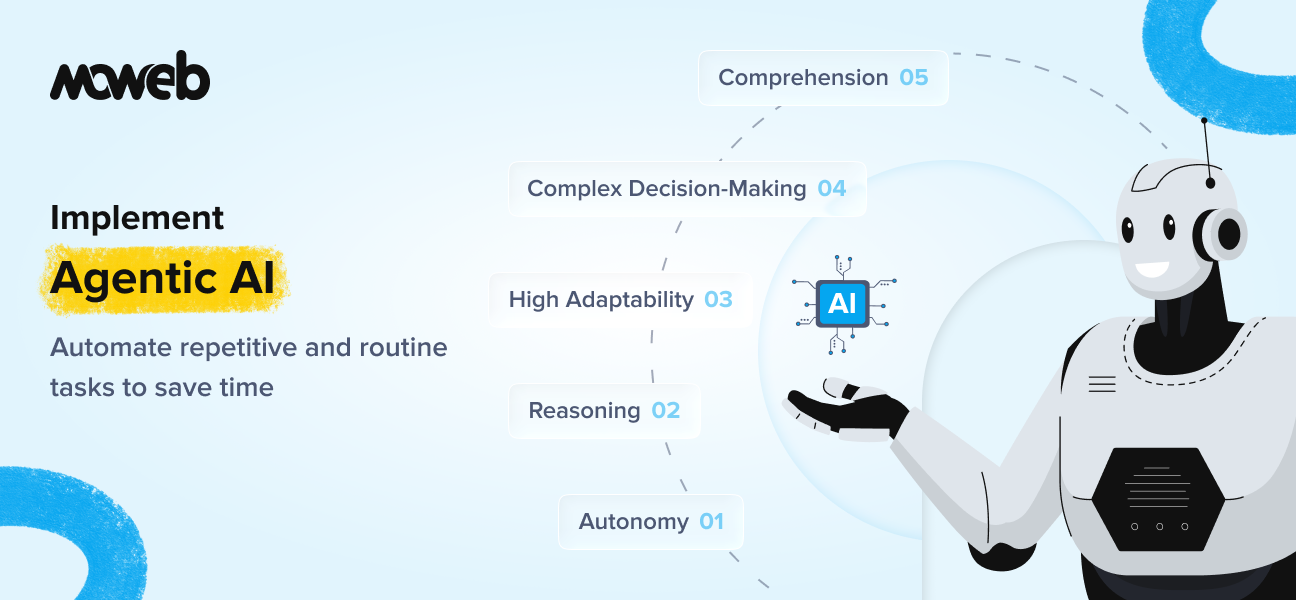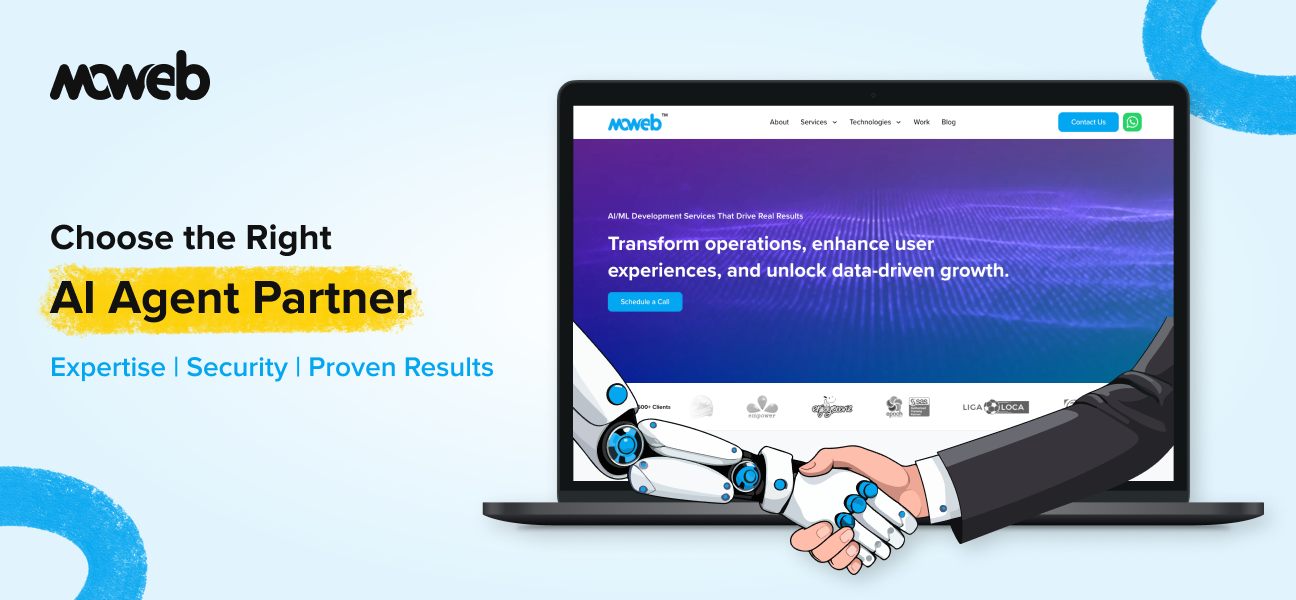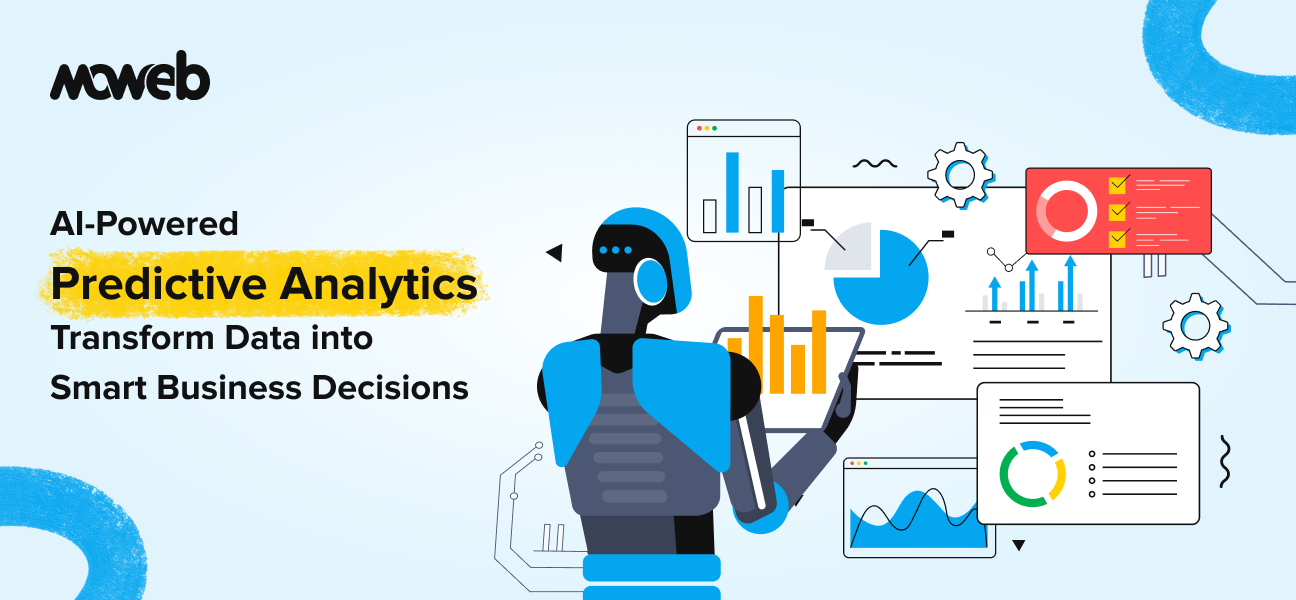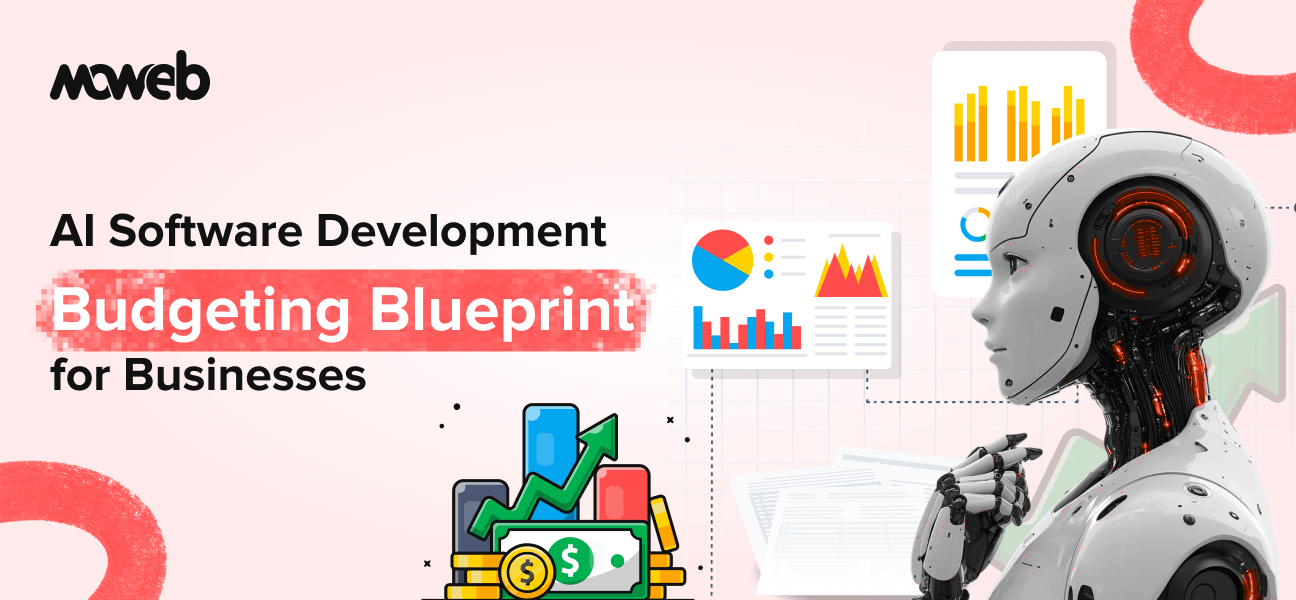
Imagine automating repetitive tasks, finding unbelievable insights from mountains of data that never seemed relevant, all at the push of a button. With AI in place, these tasks are no longer imaginable; they’re the new normal for businesses.
But if there is one question keeping industry leaders up at night, it is how much does AI software cost to build, and can your business afford to get it right? Spoiler alert: there is no one-size-fits-all answer to it. The cost of custom AI solutions can swing from the tens of thousands to well over a million dollars, depending on your goal and approach. Yet, with the right budgeting blueprint, you can make the most of AI without risking runaway expenditures or disappointing results.
In this guide, we’ll cut to the chase and reveal what really drives AI project costs and how to take control of budgeting AI projects.
Understanding AI Software Development: Beyond the Hype
AI software development is all about creating intelligent systems that can learn, adapt, and solve complex challenges. Modern AI leverages:
- Machine Learning for data-based predictions
- Natural Language Processing (NLP) for bots and document analytics
- Computer Vision for image and video recognition, and
- Generative AI for new content creation
Businesses using Artificial Intelligence can benefit deeply from automated workflows, sharp analytics, better customer engagement, and personalized experiences.
Why AI Software Cost Matters
The global AI software revenue will hit $126 billion by the end of 2025. Despite such tremendous growth, AI systems still remain complex and questionable in terms of cost. This is why there is a dire need for businesses to ensure that they know the nitty-gritty of the estimated costs.
In fact, studies show that AI project costs can rise by 500% to even 1,000% when moving from a pilot phase to full-scale production, especially when data handling, compliance, and infrastructure aren’t planned early on. This means a well-scoped and budgeted blueprint can minimize the risks and increase the ROI.


Ready to Unlock AI for Your Business?
Contact us to get a personalized quote and start building your custom AI solution today!
Key Factors Influencing AI Software Development Cost
Several key AI development pricing factors can dramatically influence how much does AI software cost. Understanding these drivers will help your business create a more realistic AI budget and avoid financial surprises.
1. Project Complexity
Simple AI (like basic chatbots) is cost-effective, while enterprise-level AI that includes integrations, analytics, and customized features demands larger investments. The more complex the logic, the higher the need for specialized datasets, model training, and testing. Plus, when AI interacts with multiple systems or users in real-time, it adds layers of development, security, and maintenance that significantly increase costs.
2. Type of AI Solution
The cost to build an AI system varies based on functionality, from basic chatbots and recommendation engines to advanced NLP, computer vision, predictive analytics, autonomous agents, and generative AI models. This can range from $10,000 to $1,500,000, which is a significant difference.
3. Data Requirements
Collating, filtering, and labeling high-quality data can take time and incur more cost, especially for specialized apps such as healthcare diagnostics, autonomous vehicles, financial fraud detection, and natural language understanding, where data must be precise, diverse, and highly contextual.
Data requirements for such apps are rigorous, needing large volumes of accurately labeled, domain-specific datasets to train AI models effectively. Additionally, ensuring data privacy, compliance, and continual updating of datasets to maintain model accuracy adds complexity and cost to the development process.
4. Team Composition & Expertise
Hiring an in-house team is often costlier than outsourcing or working with an AI development company The required skill levels, such as data scientists, analysts, and ML engineers, also have a major AI infrastructure cost.
5. Technology Stack & Tools
Using open-source frameworks generally reduces the overall cost to build an AI system as compared to proprietary APIs and commercial AI platforms. Open-source tools like TensorFlow, PyTorch, and scikit-learn provide flexible, community-supported resources with no licensing fees, making them ideal for many projects. However, certain technology stacks and tools can drive up costs, especially those requiring specialized hardware (like GPUs or TPUs), enterprise-grade AI platforms with built-in security and compliance features, or proprietary APIs from major cloud providers such as AWS, Azure, or Google Cloud.
6. Regulatory, Compliance & Security
Meeting standards like GDPR (General Data Protection Regulation) or HIPAA (Health Insurance Portability and Accountability Act) increases costs because of architecture, penetration testing, and strict data encryption requirements.
7. Maintenance & Scaling Costs
You can anticipate additional costs due to continuous software updates, technical support, and the need to scale infrastructure resources like servers and cloud services to handle growing data volumes and user demands. AI compliance requirements, such as ensuring models meet regulatory standards and auditing for bias and fairness, add complexity and cost.
Regular security monitoring is also essential to protect sensitive data and maintain system integrity, all contributing to the long-term cost of maintaining and scaling AI-powered applications.
Related Post: AI for Business Intelligence
How much does AI Software Cost?
Estimating how much does it cost to build an AI system depends on the scope, complexity, and technical requirements. Here is a quick overview of the average AI development costs for various types of solutions. You can refer to these estimates as a starting point when budgeting your next AI project.
| Solution Type | Estimated Cost Range |
| 1. MVP / Basic AI App | $10,000 – $50,000 |
| 2. Mid-Tier AI System | $50,000 – $150,000 |
| 3. Enterprise-Grade Solution | $250,000 – $1,000,000+ |
| 4. Computer Vision System | $80,000 – $150,000 |
| 5. Simple AI Chatbot | $10,000 – $49,999 |
These ranges reflect development costs in 2025 and may vary by region, technology stack, and the experience level of your development team.
Related Post: How AI Is Transforming Supply Chain Management
AI Software Development Key Cost Drivers
While budgeting AI projects, understanding the primary cost drivers can help you make smarter decisions and allocate resources more effectively. They include:
- Project Complexity & Software Type: The more features, integrations, and business logic your AI solution requires, the higher the cost. Simple applications demand less time and skill than multi-functional, enterprise-level platforms.
- AI Model Sophistication: Costs rise with the complexity of algorithms, the need for custom models, and requirements for high performance. Developing and refining advanced models takes significant expertise and computational power.
- Data Acquisition, Cleansing, and Annotation: Collecting suitable data, ensuring quality, cleaning, and labeling data all contribute heavily to overall expenses.
- Tech Stack & Infrastructure: Your choice between Cloud-based versus on-premises solutions, reliance on GPUs for deep learning, and open-source or commercial frameworks affects upfront and ongoing investment.
- Team Structure: Whether building an in-house team or outsourcing it, salaries, experience levels, and regional pay rates play a major role. Outsourcing or partnering with a professional AI development company can provide cost efficiency for projects with diverse needs.
Hidden and Recurring Costs of AI Software Development
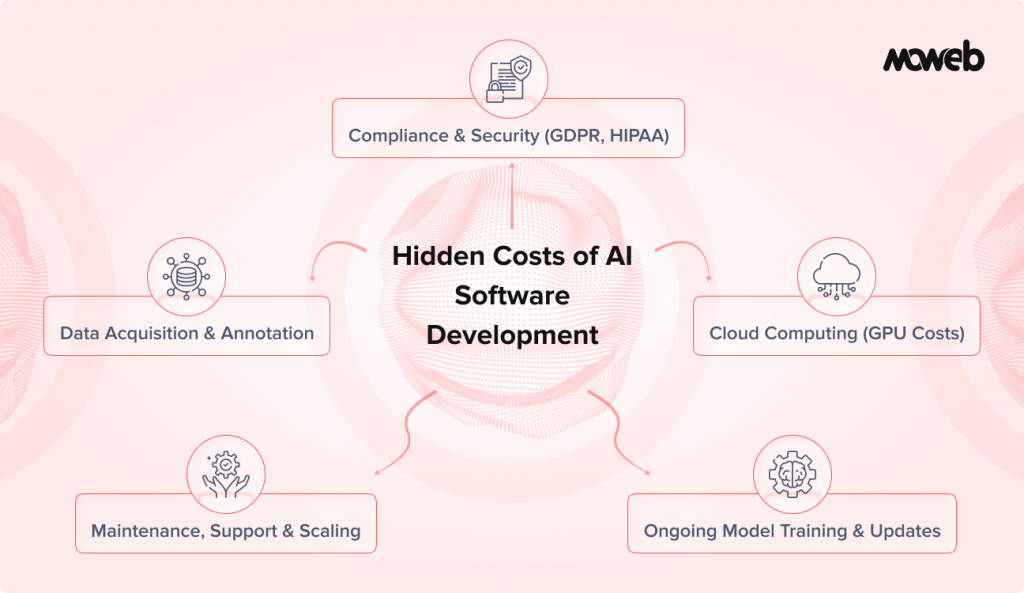
There are many other costs that lurk beneath the surface. Some of these include:
- Data Acquisition & Annotation: Gathering and labeling high-quality datasets either involves manual effort or requires purchasing specialized data that can add up to significant ongoing expenses.
- Cloud Computing (GPU Costs): As your AI system grows, the AI cloud infrastructure cost, especially for GPU-intensive training and inference, can scale up in price.
- Compliance & Security (GDPR, HIPAA): Maintaining data privacy and compliance requires investment in architecture changes, audits, encryption, and periodic legal updates.
- Maintenance, Support & Scaling: Continuous monitoring, bug fixing, upgrading algorithms, and expanding infrastructure come with unavoidable costs.
- Ongoing Model Training & Updates: Real-world data changes over time, making retraining and updating models a necessary and recurring cost.
How to Reduce AI Software Development Costs Without Sacrificing Quality
Balancing quality and budget is easily possible with strategic decisions throughout the AI development process. Here are some of the ways to control AI infrastructure costs while maintaining quality:
- Use Pre-trained Models: Leverage established I models like GPT or solutions from TensorFlow and Hugging Face to minimize development time and costs.
- Outsource Non-Core Tasks: Delegate data annotation cost, quality analysis, or non-strategic development tasks to specialized partners or an AI development company.
- Start with an MVP: Focus on solving the core business problem first. Then, validate your idea and add features in multiple phases.
- Leverage Open-Source Tools: Opt for an open-source framework and libraries to reduce licensing fees and use community-backed technology.
Step‑by‑Step Budgeting Blueprint of AI Software Development
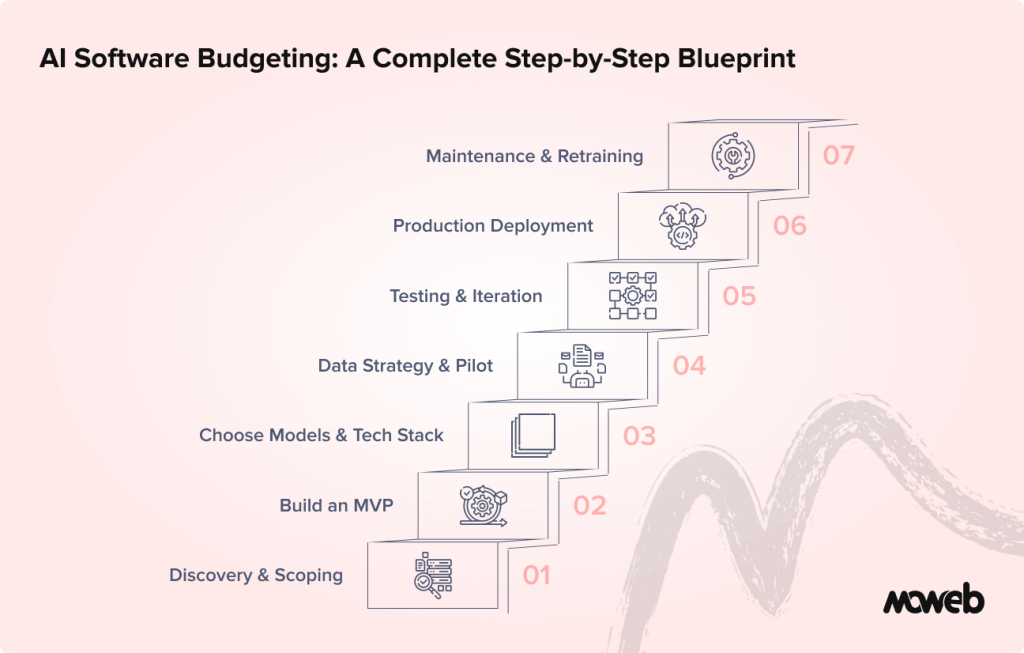
A systematic approach to budgeting AI projects ensures every phase of your AI project is financially planned, minimizing the risk of overspend and surprises.
- Discovery & Scoping: Define business objectives, user requirements, and success criteria.
- Build an MVP: Develop a minimum viable product to test core AI features with minimal investment.
- Choose Models & Tech Stack: Select AI frameworks and infrastructure that match your requirements and budget.
- Data Strategy & Pilot: Develop a plan for data collation, cleaning, and labeling. Run pilot projects to validate the feasibility.
- Testing & Iteration: Continuously test, refine, and improve your models and workflows based on user and stakeholder feedback.
- Production Deployment: Carefully roll out your AI system, ensuring robust monitoring and scalability.
- Maintenance & Retraining: Plan for regular updates, compliance checks, and retraining as new data is collected and requirements change.
Strategies to Optimise Costs of AI Software Development
Effective cost optimization in AI projects requires smart planning from start to finish. By employing the right strategies, you can maximize value while keeping budgets in check.
- Start with an MVP & Phased Rollout: Focus your initial investment on a core, testable product. Expand to more features and complexity only after validating success.
- Leverage Open-Source & Pre-Trained Models: Use reputable frameworks like TensorFlow and PyTorch, and established models. This cuts down the development time and avoids high licensing fees.
- Outsource Smartly: Combine in-house oversight with external partners to balance quality, innovation, and labor costs.
- Use Cloud Services, Not On‑Premise Heavy Infra: Cloud platforms like AWS, Azure, or GCP offer flexible, pay-as-you-go infrastructure, helping you avoid massive upfront hardware investments.
- Plan for Compliance Early: Addressing regulations (GDPR, HIPAA, etc.) at the design phase helps avoid costly rework and ensures smoother audits and rollouts.
Conclusion
The cost of custom AI solutions is influenced by many AI development pricing factors such as project complexity, type of AI solution, data requirements, technology stack, team structure, and ongoing maintenance. Understanding these drivers and adopting proactive budgeting and cost optimization strategies ensures your investment is both smart and sustainable.
Start by analyzing your business goals and clearly defining your project’s scope to avoid unnecessary complexity. Choose an AI solution and tech stack that fits your needs and budget. Begin with a minimum viable product (MVP) to validate core features before scaling. Collaborate with experienced partners like an enterprise software development company for expertise and cost efficiencies. And make sure to plan ahead for recurring costs such as maintenance, compliance, and infrastructure to keep your AI environment reliable and scalable.
Contact Moweb today for a tailored cost estimate and let experts help you build an AI solution that fits your vision and budget.
Found this post insightful? Don’t forget to share it with your network!



